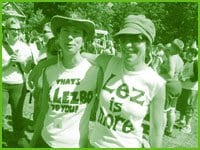Vancouver’s first-in-a-decade dyke march was definitely worth the drive for Forest Sterling. The 18-year-old queer drove all the way from Fernie, BC to attend this year’s Pride celebrations. Now, standing under a tree in Grandview Park Jul 31, surrounded by about 2,000 dykes, dogs and allies, Sterling simply can’t stop smiling.
“I feel empowered,” she says. “It’s been very, very rad. Full of estrogen, full of excitement.”
It’s almost not real, she continues. “I’ve never, ever seen anything like this. I’m coming from Fernie, where if you find a rainbow flag anywhere, it’s amazing.”
When asked what participating in the march and its after-festival in the park means to her, Sterling doesn’t hesitate. “Everything,” she says.
“It’s very, very exciting.”
Liana Eadie couldn’t agree more. Xtra West caught up to her walking down Commercial Dr in the middle of the march. “I feel complete,” says the 24-year-old Cranbrook resident. “Everything I stand for is right here.”
Like Sterling, Eadie drove about nine hours to attend this year’s Pride festivities and inaugural Pride dyke march. Like Sterling, she isn’t disappointed.
Neither is Colleen Mangin, a 33-year-old East Vancouver resident. “There’s something about the power of a whole group of women,” she says. “This gives us a place to be who we are.”
Though she enjoys the usual Pride celebrations, Mangin says having a march specifically for dykes is special. “It’s really important so that I have a place to celebrate who I am, individually as well as in a group,” she explains. It’s good to be in the majority for a change, she adds.
Amy Ostrosser summarizes what the march means to her in one word. “Happiness,” says the 26-year-old, as she and her friend’s border collie try to match their pace to the other dykes marching around them. “[It means] being somewhere we can actually be ourselves, and we don’t have to worry about anything.”
It’s about “expressing our freedom without reservation,” adds Valerie Anaya. The 59-year-old travelled from Salt Lake City, Utah specifically to participate in Vancouver’s dyke march. She’s been organizing her own city’s dyke marches for the last seven years. “I’m just glad to be here,” Anaya says, smiling at her Canadian partner. The couple got engaged the night before the march.
Xtra West catches up to Vancouver Pride Society president Shawn Ewing as the march wends its way from Victoria Park, west on Grant St, then north a few blocks on Commercial Dr to its destination in Grandview Park, where a stage has been set up and a number of local dyke and drag king performers are waiting to volunteer their time.
Ewing can’t believe how lucky she is to have just walked down Commercial Dr openly holding her girlfriend’s hand, surrounded by other dykes. “It’s quite amazing,” she says, recalling a time not so long ago when she and her girlfriend were closeted teenagers hanging out on the Drive. After losing touch for almost two decades, they found each other again last year. This weekend they walked as a couple in the dyke march.
Ewing’s girlfriend, Karen Neufeld, is feeling quite emotional. “It’s almost indescribable. I said to [Shawn], ‘could you imagine we’d be here 30 years ago?'” Neufeld says, referring not only to their renewed partnership but the community’s presence as a whole.
“I think it’s a celebration of who we are and where we come from.”
It’s not the first time dykes have taken over Commercial Dr. Myrn McLaughlin, one of the founding members of the now-defunct Dykes for Dykedom, recalls the marches her group helped organize here in the late 1980s and early 1990s.
It was a different time then, McLaughlin says. The old marches were part of Vancouver’s International Lesbian Week; they weren’t affiliated with the Pride festivities at all. And they didn’t get city permits, either. Back then, the participants simply took back the street, she notes.
Still, McLaughlin says she’s happy to see a new generation of dykes picking up the torch and doing it their way today. This dyke march is going to make Pride “richer,” she says.
Bet Cecil agrees. She, too, helped organize the earlier dyke marches when she co-ran the Vancouver Lesbian Centre in the 1980s and ’90s. “I am so fucking delighted with what these women have done,” she says. “They’ve done a superb job.
“The next generation seems to have a sense of entitlement and a comfort with who they are that I find delightful,” Cecil continues. “And it’s built on the work that we did-whether they know it or not.”
Behind the stage, co-organizers Michelle Walker and Heidi Deagle are basking in the success of their day. Walker can’t get over the number of people who turned out for the march and stayed for the festival in Grandview Park. “It’s just awesome,” she smiles, exhausted but happy.
“I had goosebumps,” she continues, recalling the march’s first steps. “Just being able to walk down the street, knowing there are hundreds of people in front of you. . . . It was really empowering.”
She and Deagle first came up with the idea for a local dyke march after attending last year’s march in San Francisco. “It was really inspiring,” Deagle told Xtra West in April, adding that she hoped to recreate the positive energy here. Now, she says, pausing to share the credit with the rest of the organizing committee and all the volunteers, this march has exceeded her expectations.
When asked if they’ll do it again next year, Walker doesn’t hesitate.
“Oh hell, yeah,” she grins.

 Why you can trust Xtra
Why you can trust Xtra


